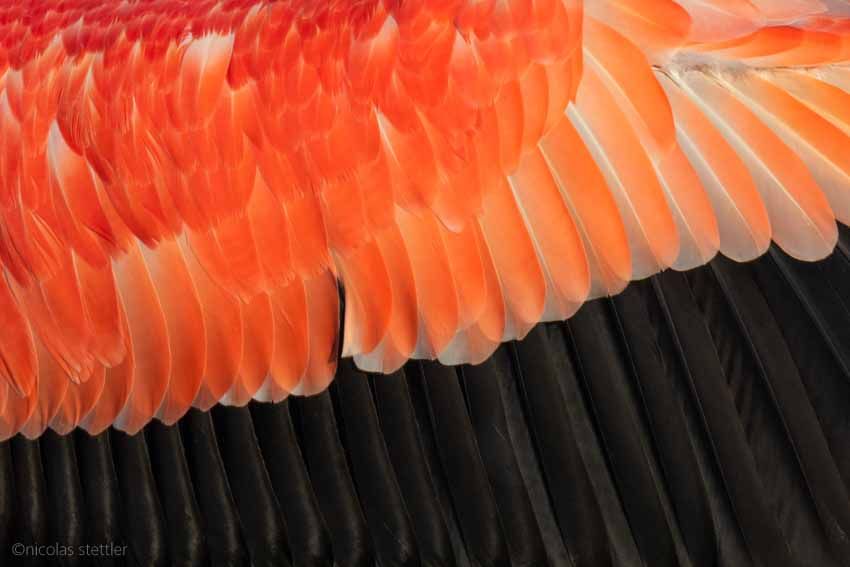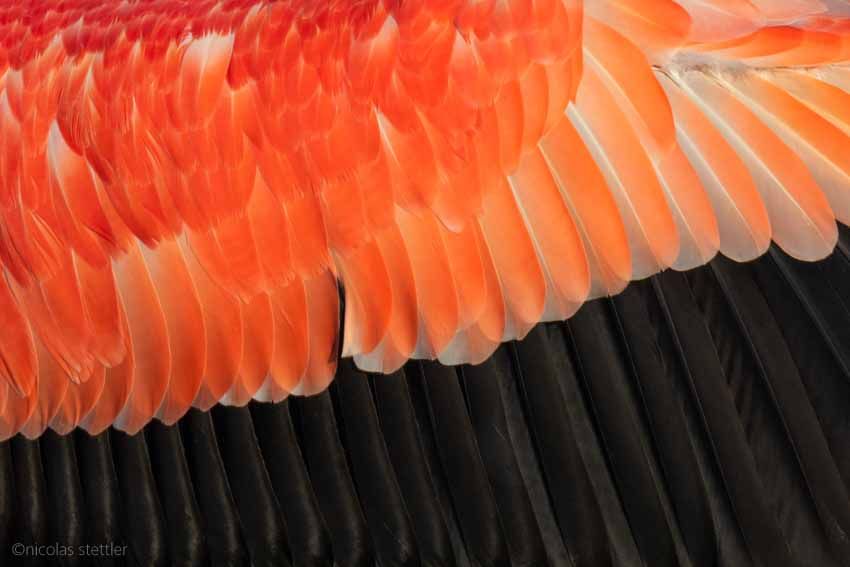Wing of a Greater flamingo
Settings
Exposure: 1/800
Aperture: f/ 6.3
ISO-Sensitivity: ISO 280
Focal length: 600mm
Lens: Sigma 150-600mm F5-6,3 Sports
Camera: Nikon D850
Last autumn I was in the Camargue in the south of France for 2 weeks. Camargue is home to an enormous variety of species and it’s a paradise for every birdwatcher and photographer. The Camargue is especially famous for one kind of birds. In the Camargue live thousands of Greater flamingos. These can be observed almost everywhere.
The water bodies in the Camargue dry out in late summer. As a result, many birds were far away from the paths, in the middle of the nearly empty water bodies. In many places this was too far away to take pictures.
In the Camargue there is a park where the water level is regulated all year round. Therefore, many species move to the ponds of the Parc Ornithologique de Pont de Gau. The birds are also fed with empty rice husks. The flamingos, which live in the wild, use this food source and many of the birds stay at the ponds all year round. A path has been built around the pond and the flamingos can be observed and photographed from only a few metres. They have become accustomed to people and show practically no shyness anymore.
While at first, I had devoted myself to taking portraits of the flamingos, I gradually realized that this would not work out so well. I was not the only photographer who was in the park that night and I realized that the standard portrait had probably been shot thousands of times. So, I tried to capture some more unique details and behaviour.
Every couple of minutes, more flamingos landed at the pond. Other birds, on the other hand, took off and were probably already heading for their sleeping place. So, I tried to photograph the flamingos in flight. Because the flamingos have a very long and thin body, I could not find any composition that did not make the birds look awkward. I also tried to capture the birds with longer exposure times to show some motion. But the same problem occurred here, too. In addition, the background was not very nice and so I abandoned the idea of a photo of the flamingo in flight.
I noticed that when a group of flamingos were about to land, the flamingos on the ground spread their wings. In doing so, the flamingos showed their strongly red coloured wings, which are framed by dark hand and arm wings. The problem was that I never knew which flamingo would spread its wings. The flamingos showed this behaviour quite often, but they only spread their wings for a few seconds. The autofocus of my Sigma 150-600 Sport was just too slow to focus on the wings in time.
So, I lowered the camera for a few minutes to see if the wing spread could be predicted. Although I couldn't see any specific behaviour that could tell me which Flamingo would spread its wings, the short pause seemed to help me a bit anyways. The few milliseconds I could detect the behaviour earlier was enough and the autofocus had enough time to focus. After some more failed attempts I finally had a sharp picture of the wings.
Das könnte dich auch interessieren:
Photographing water birds | How to get close to ducks
In the recent winters I have concentrated on photographing water birds and especially ducks. This is a blog article about how I get so close to these very interesting species. I explain to you what I have for tricks and why the location is so important.
Bird Photography - Create impressive Images
Photographing birds can be very difficult. In this article you will learn how to create impressive and unique pictures of birds. I explain what you should pay attention to when taking pictures and where you can find birds that you can easily photograph. Learn from my tips and tricks, which I myself have learned in the last years while photographing.



